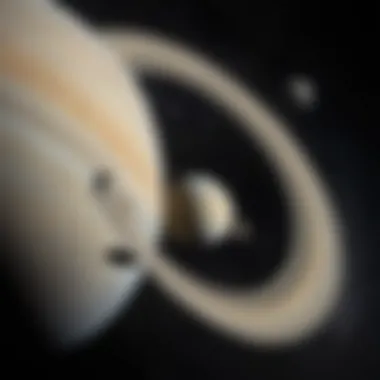Unveiling the Enigmatic Planets of Our Vast Solar System


Science Fun Facts
Astonishing fun facts about the planets in our solar system! From the crushing gravity of Jupiter to the icy rings of Saturn, each planet boasts fascinating characteristics waiting to be explored. Did you know that Venus is the hottest planet in our solar system, even hotter than Mercury? Dive into the world of planetary curiosities and unlock the secrets of our cosmic neighbors.
Discover the Wonders of Science
Unravel the mysteries of the planets through engaging scientific concepts. Explore the force of gravity with educational videos demonstrating orbital mechanics. Delve into the colors of Mars and the atmospheric pressure on Venus using interactive learning tools. Discover real-life applications of space exploration and inspire young minds to reach for the stars.
Science Quiz Time
Test your knowledge with interactive quizzes on planetary facts. Can you guess which planet is known as the "Red Planet"? Engage in brain teasers and puzzles to challenge your understanding of the solar system. Dive into gamification and enhance learning while having fun discovering the wonders of the universe.
Science Experiment Showcase
Embark on a journey of scientific discovery with fun and engaging planetary experiments. Follow step-by-step instructions to create a model of the solar system using simple materials. Discover the importance of safety with tips on handling chemicals and using protective gear. Engage in hands-on learning and witness the magic of science come to life before your eyes.
Introduction
Understanding Our Solar System
The Sun as the Center of Our System
At the core of our solar system lies the mighty Sun, a fusion reactor that illuminates and sustains life on Earth. The Sun's gravitational pull dictates the orbits of planets, shaping the dynamics of our celestial neighborhood. Its immense heat and energy fuel the processes that drive life on our planet, highlighting its pivotal role in our existence. The unique feature of the Sun as our system's nucleus lies in its ability to synthesize elements and radiate solar wind that influences interplanetary space.
Planetary Orbits and Distances
The arrangement of planets in our solar system is a harmonious dance dictated by their orbital paths and varying distances from the Sun. Understanding the intricate balance of planetary orbits unveils a symphony of gravitational forces and celestial mechanics. The key characteristics of planetary orbits provide insight into the vastness of space and the precise movements that govern planetary motion. While these orbits offer a wealth of information about our system, they also present challenges in terms of space exploration and mission planning.
Importance of Studying Planets
Insights into Earth's Origins
Studying planets beyond Earth offers a unique perspective into the formation and evolution of our home planet. Insights gained from exploring other celestial bodies shed light on Earth's geological history, atmospheric composition, and potential catastrophic events. This comparative analysis allows scientists to extrapolate valuable information about Earth's past and potential future, enhancing our understanding of planetary processes.


Potential for Extraterrestrial Life
One of the most compelling reasons for studying planets is the possibility of encountering extraterrestrial life forms. Exploring diverse environments within our solar system and beyond provides insights into the conditions necessary for life to thrive. By examining the potential for microbial life or complex organisms on other planets, scientists expand the scope of our understanding of life's adaptability and the vast possibilities of existence beyond Earth.
Inner Planets
Exploring the inner planets is a significant aspect of delving into our solar system. These planets, namely Mercury, Venus, Earth, and Mars, offer unique insights into the characteristics and conditions that could support life beyond our own planet. Understanding these inner planets is crucial for scientists in determining the potential for habitability within our solar system. Each planet presents distinct features and challenges that enrich our understanding of planetary systems.
Mercury
Characteristics and Composition
Mercury, the closest planet to the sun, is a testament to extremes. Its surface is marked by rugged terrains and vast plains, showcasing a stark juxtaposition of light and dark features. The composition of Mercury consists mainly of silicate rock and metals, giving it a dense and cratered appearance. This planet stands out for its lack of a substantial atmosphere, which results in dramatic temperature shifts between its scorching days and freezing nights. Despite its proximity to the sun, Mercury harbors ice in permanently shadowed craters, adding to its enigmatic nature.
Extreme Temperatures
The extreme temperatures on Mercury are a defining characteristic of this barren world. With highs reaching temperatures over 400°C (752°F) during the day and dropping to lows of around -180°C (-292°F) at night, Mercury experiences the most significant temperature variation of any planet in our solar system. These extreme conditions pose challenges to potential future missions, making exploration and research endeavors on Mercury a formidable task. However, scientists continue to uncover vital information about this planet's geological history and evolution despite these harsh environmental conditions.
Venus
Greenhouse Effect
Venus, often dubbed Earth's
Asteroid Belt and Gas Giants
The section on the Asteroid Belt and Gas Giants in this article serves as a pivotal point of exploration within our solar system. By delving into the Asteroid Belt and the Gas Giants, we unearth a wealth of information that sheds light on the dynamics of our cosmic neighborhood. Understanding the composition and characteristics of the Asteroid Belt alongside the intriguing aspects of the Gas Giants opens up a gateway to comprehending the broader scope of planetary systems.
Asteroid Belt
Composition and Origin
Exploring the Composition and Origin of the Asteroid Belt provides a fascinating insight into the genesis of these celestial bodies. The Asteroid Belt, situated between Mars and Jupiter, comprises remnants of the early solar system that never formed into a cohesive planet. Its composition, consisting mainly of rock and metal, offers clues to the conditions that existed during the formation of our solar system. This unique feature of diverse materials within the Asteroid Belt makes it a treasure trove for scientific study, offering a glimpse into the primordial material that orbits our Sun.


Role in Solar System Dynamic
Analyzing the Role of the Asteroid Belt in the dynamic equilibrium of our solar system yields invaluable information regarding its influence on planetary movements. The gravitational interactions within the Asteroid Belt play a crucial role in shaping the orbits of planets and other celestial bodies in our system. Understanding how the Asteroid Belt affects the trajectory of objects within our solar neighborhood enhances our comprehension of the intricate dance of celestial bodies. Despite its challenges, such as potential collision risks for spacecraft and satellites, the Asteroid Belt stands as a pivotal element in maintaining the stability of our solar system.
Jupiter
Discovering the mysteries of Jupiter, with its Giant Storms and Moons, uncovers captivating facets of this gas giant's existence. The tumultuous storms that rage across Jupiter's atmosphere and the multitude of moons that encircle its massive form offer a window into the wild wonders of this colossal planet. Observing the chaotic beauty of Jupiter's storms and the celestial ballet of its moons provides key insights into the cosmic forces at play within our solar system.
Giant Storms and Moons
The intense Giant Storms of Jupiter, notably the Great Red Spot, showcase the awe-inspiring power of atmospheric phenomena on a massive scale. These storms, fueled by the planet's composition and rotation, create breathtaking visuals that mesmerize astronomers and space enthusiasts alike. Jupiter's diverse array of moons, especially the Galilean Moons, each with its distinct features and interactions, enrich our understanding of planetary systems' complexities and diversity.
Galilean Moons
The Galilean Moons of Jupiter – Io, Europa, Ganymede, and Callisto – stand out as worlds teeming with geological activity and potential for scientific exploration. From volcanic eruptions on Io to the potential subsurface oceans of Europa, each moon offers a unique perspective on celestial bodies' potential habitability and geological diversity. Studying the Galilean Moons unlocks a realm of possibilities for understanding the evolution and conditions of planetary bodies beyond Earth.
Saturn
Saturn, renowned for its Iconic Rings and fascinating moons like Titan and Enceladus, presents a captivating subject within our solar system exploration. The iconic rings that encircle Saturn and the enigmatic moons that orbit this gas giant offer a glimpse into the spectacular and diverse phenomena that define Saturn's allure.
Iconic Rings
The Iconic Rings of Saturn, composed of icy particles and debris, form a breathtaking sight that has captivated skywatchers for centuries. These rings, organized into distinct bands, highlight the intricate dance of gravitation and celestial dynamics. Their sheer beauty and complex structure make them a subject of fascination and scientific inquiry, providing essential clues to the processes that shape planetary ring systems.
Titan and Enceladus
Among Saturn's celestial entourage, Titan and Enceladus emerge as worlds of profound interest and scientific intrigue. Titan's dense atmosphere and methane lakes, coupled with Enceladus' ice plumes and subsurface ocean, hint at the potential for habitable environments beyond Earth. Exploring these moons not only enhances our grasp of planetary diversity but also sparks imaginations regarding the possibility of extraterrestrial life within our solar system.
Uranus
Uranus, with its Unique Tilt and Magnetic Field characteristics, offers a distinctive perspective on the dynamics of gas giants. The unusual tilt of Uranus' axis and its peculiar magnetic field properties provide an in-depth look at the varied phenomena that govern this enigmatic planet.
Unique Tilt and Magnetic Field


The Unique Tilt of Uranus' axis, nearly perpendicular to its orbit, sets it apart from other planets in our solar system. This axial tilt results in extreme seasonal variations and a unique pattern of light and heat distribution across the planet. Uranus' Magnetic Field, offset from its center and significantly weaker than other gas giants, poses intriguing questions about the planet's interior dynamics and magnetosphere. Although these characteristics present challenges for scientific investigation, they also offer profound insights into the complexities of planetary formation and evolution.
Icy Composition
Uranus' Icy Composition, comprising elements like water, ammonia, and methane in various forms, characterizes the frigid nature of this distant gas giant. The icy components of Uranus' atmosphere and interior contribute to its distinct appearance and atmospheric properties, shaping the planet's behavior and weather patterns. Studying Uranus' icy composition unveils a world of icy giants' unique features within our solar system, offering valuable comparisons and contrasts with other gas giants.
Neptune
Neptune, the Blue Planet adorned with the intriguing Trident Moon, beckons explorers to delve into its aquatic mysteries. The vibrant blue hues of Neptune's atmosphere and the enigmatic features of its largest moon, Triton, provide a captivating canvas for celestial inquiry.
Blue Planet
Neptune's distinctive Blue Planet appearance arises from the presence of methane in its atmosphere, giving rise to the planet's striking azure coloration. This characteristic feature distinguishes Neptune as a unique player among the gas giants, offering a visual spectacle that mesmerizes astronomers and space enthusiasts alike. Understanding the mechanisms behind Neptune's mesmerizing blue hues unravels the complexities of atmospheric chemistry and planetary dynamics.
Trident Moon
The peculiar Trident Moon, Triton, orbits Neptune with its retrograde motion and geologically diverse terrain, piquing curiosity about its origins and evolution. Triton's icy surface, geological activity, and unusual orbit around Neptune present a myriad of questions about its formation and relationship with its parent planet. Exploring the enigmatic Trident Moon provides valuable insights into the dynamic interplay between moons and their host planets, deepening our understanding of celestial mechanics and planetary interactions.
Beyond Our Solar System
When discussing the vast expanse of space exploration, venturing Beyond Our Solar System holds a pivotal significance. This section delves into the realm of exoplanets and interstellar exploration, expanding the horizons of our cosmic understanding. It offers a glimpse into the limitless possibilities and extraterrestrial landscapes awaiting discovery. Traversing Beyond Our Solar System unlocks a trove of new worlds, enabling humanity to grasp the intricate tapestry of the universe beyond familiar boundaries. By shedding light on exoplanets and interstellar phenomena, this segment ignites curiosity and fosters a deep appreciation for the boundless nature of space.
Exoplanets
Discoveries and Varieties
By exploring the intriguing realm of Exoplanets' Discoveries and Varieties, we unearth a myriad of distant planetary systems. Each discovery adds a new layer to our cosmic understanding, unveiling planetary compositions that challenge the conventions of our solar system. The unique allure of Exoplanets lies in their sheer diversity and their potential to harbor life forms beyond our wildest imagination. The wide array of Exoplanet discoveries enriches our exploration methodologies, pushing the boundaries of astronomical knowledge to unseen heights. While navigating through the complexities of Exoplanetary systems, astronomers uncover tantalizing prospects for future discoveries, propelling scientific inquiry into uncharted territories.
Habitable Zone Criteria
In delving into the intricate details of the Habitable Zone Criteria for Exoplanets, scientists unveil the factors crucial for sustaining life beyond Earth's protective embrace. The concept of habitable zones defines the regions where conditions are conducive to supporting life as we know it. By discerning the key parameters governing these zones, researchers can identify Exoplanets with the potential to nurture biological ecosystems akin to our own. The significance of Habitable Zone Criteria encompasses the quest for extraterrestrial habitats and the pursuit of understanding life's cosmic prevalence. Exploring these criteria underscores the delicate balance needed for fostering life and underscores the fundamental principles guiding astrobiological inquiries.
Interstellar Exploration
Challenges and Future Prospects
Interstellar Exploration poses a myriad of challenges that necessitate innovative solutions and unwavering determination. The vast distances and extreme environments encountered beyond our solar system present formidable obstacles to exploration. Overcoming these challenges demands cutting-edge technologies and collaborative efforts on a global scale. By tackling the obstacles inherent in Interstellar Exploration, humanity lays the groundwork for future cosmic endeavors, revolutionizing our perspectives on space travel and discovery.
Potential for Intergalactic Discoveries
The realms of space tucked away in Potential for Intergalactic Discoveries hold the promise of unveiling cosmic secrets beyond imagination. By delving into the uncharted territories of intergalactic space, we open doors to profound revelations and groundbreaking insights. The allure of intergalactic discoveries lies in their potential to reshape our understanding of the universe, paving the way for paradigm-shifting breakthroughs in astrophysics and cosmology. Exploring the depths of intergalactic space not only fuels scientific curiosity but also inspires future generations to reach for the stars in pursuit of knowledge and discovery.







